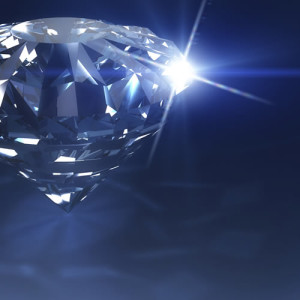A COURSE IN DIAMONDS

Understanding Diamonds and Fine Jewelry
Learning about Diamonds and their Grading
Introduction
Since this learning program is designed for beginner through advanced student and since the learning process is a continuous endeavor, all information for all levels will be presented together. The beginning level material will appear in blue, the intermediate in burgundy and the advanced in italic red. To be able to start shopping at least for some preliminary information on shape and size diamond that’s ideal for you, make certain you have read all the blue course material. When you are comparison shopping for prices you must have mastery of the intermediate, burgundy materials. If you are considering diamonds as a hobby, investment or business opportunity you will want to familiarize yourself with the advanced sections in italic red.
Parts of a Diamond
Illustration of round brilliant cut with all parts and facets named
Cutting and Carat Weight
The evolution from octahedral crystal (or another crystalline form) to finished gem is an appropriate opening. Since, excluding diamonds with perceptible, pleasing body color (fancies), diamonds are devoid of color, their beauty is dependent upon the mastery of the cutter. It is this mastery that will optimize the brilliance and spectral color display (dispersion) of the diamond. However, it is not always the sole objective of the cutter to produce a diamond ofoptimal beauty, but rather to produce one of maximum weight. It is this concept that underlies all consideration of cutting grade vs. price in the diamond industry and hence the most important concept in this course of study.
Chart showing rough vs. cut
Evaluating Cutting Quality – Using the round brilliant cut as an example, the easiest way to make an estimation of cutting quality is to examine the depth and table percentages. These will be found on the certificate from the Gemological Institute of America that normally accompanies a fine quality diamond. Should you consider the risky practice of purchasing a non-certified diamond, the appraiser who evaluates the diamond for you can provide you with this information. For recommended guidelines of certificate parameters, see the IGS Proportion Chart.
These percentages are calculated from the average cross-sectional size of the diamond as reflected by the average diameter. The depth percentage is measurement of depth divided by diameter. The ideal depth for a round brilliant is 60%. From time to time, round diamonds are encountered that are not exactly round.
If the diameter extremes vary by more than 2% the diamond is out of round. The novice shopper frequently overlooks this point.
The table percentage demonstrates how much of the cross-sectional area is table and how much is crown angle. The ideal table is 53% and is infrequently encountered. A “trade ideal” of 60% table is frequently seen and acceptable in most fine jewelry circles. The smaller table diamonds are more expensive to produce but are sought after by diamond fanciers because of the larger prism (greater area of crown angle) capable of dividing light into its spectral colors created by the smaller table.
Many students are curious as to how he table is measured since it is an octagon. A microscopic millimeter “ruler” is placed over the table and the measurement taken point to opposite point of the octagon. A method of visual inspection of the two squares that make up the octagon. Visual estimates of table size can be made (with practice) depending upon the degree to which the sides of these squares bow in or bulge out.
Color
The color of a diamond is best described as its degree of whiteness (fancy colors aside). The beauty of a diamond is usually related to how white it is, consequently whiteness has a profound effect on value. Color, when present, will normally be yellow in what are called Cape Series Diamonds or brown in what are called brown series diamonds. The most important factors in considering color are:
- G.I.A. has established a letter scale with D as the whitest that advances through Z of the alphabet and then utilizes color name descriptions such as light yellow.
- Individual variation from one color to the next is very slight. As many as five color grades or more difference might have to be spanned in order to see a difference face-up in color.
- In light of point 2 it is necessary to make color judgements by comparison looking through the side of the diamond rather than the top. It is imperative to view transmitted rather than reflected light. Actual color grading is done with a light source equivalent to north daylight on a white background, see picture below:
(Color comparison jpg )
- While minor, fluorescence, the emission of light in response to ultraviolet illumination, has an effect on the value of a. diamond when present in more than slight or faint amounts. For colors D-H, medium, strong and very strong fluorescing diamonds are discounted 1-15%. Colors I,J and K are increased 2-4% in the same degrees of fluorescence. The fluorescence penalty is much greater in IF through VVS clarity diamonds.
Diamonds that fluoresce yellow, while rare, can be discounted 10%. In theory, the fluorescence (usually blue) is thought to “bleach” the diamond making it look whiter than it really is.
- Many “systems” of color grading exist. The following table relates them to one another. Insert tableClarityWhile in many ways nature is perfect, nature is also imperfect. Imperfection as we apply it to diamonds is called clarity and the things that affect clarity are for the most part are called inclusions. Feathers, included crystals and pinpoints are the most common internal inclusions. External imperfections are also considered and can be nicks, extra facets and naturals that are areas of the original “skin:” or surface from the original rough diamond. Here are some important factors to consider:
- The “standard” of magnification is the ten power (written 10X) jeweler’s loupe. Our studies show that the one made by Zeiss is far superior to any other.
- While laboratories claim to do all grading with a 10X loupe, that simply is not the case. You will find it impossible to duplicate laboratory results using a loupe even one as high quality as our Zeiss. Please refer to our How to use a loupe
instructions.
- Inclusions can provide a valuable means to identify your diamond. For this the loupe is most handy. Shape, type of, color and size of inclusion can all be noted.
-
- You will find it difficult to find inclusions in diamonds above VS-2 in clarity. Please refer to the clarity chart below: (insert clarity chart here)
- Generally, fine diamonds will have clarity of SI-1 or better with the greatest concentration of finer diamonds found in the VS-2 to VVS-2 region. Better clarities are more the province of collectors or other discerning buyers. A point of diminishing returns is met as clarity surpasses VS-1 in the opinion of many diamond people.
- Nature size and type of inclusions is a study unto itself. Most diamond professionals avoid black inclusions. Inclusions that appear black may be black or may appear black because of the way the light strikes them. Detailed description of all inclusions is beyond the scope of this course.
Relating the above to purchasing your ideal diamond
Comparison If there is a fifth “C” it is comparison. The most experienced diamond people in the world use comparison to make quality judgements. Whiteness, brilliance, beauty, scintillation and total reflection are all ultimately relative terms. Use side-by-side comparisons to aid your decision-making.
Grading within a Grade Our diamond program has the versatility to enable us to stock only the most desirable diamonds within a grade. This is of paramount importance to the buyer. In this business, most accumulated inventories represent a concentration of less desirable diamonds. Be a savvy shopper, don’t get stuck with a diamond that is at the low end of the grading range. With our grading within a grade you get the advantage of our collected expertise in finding the ultra-sharp representatives of a grade. There are unsightly SI-1’s and there are SI-1’s that have greater desirability than some VS-2’s; that is where we shine!



